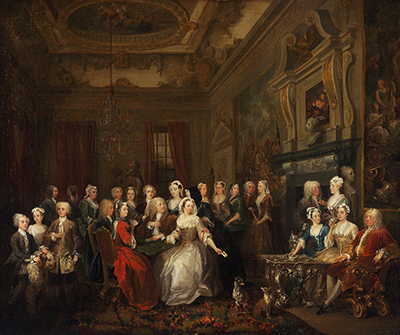The Assembly at Wanstead House has earned profound recognition as one of William Hogarth's prolific realism style works of art that depicted satire, and Mockery, and that pictured and defined the English society making fun of the existing aristocracy period, especially of the rich and the political class in the early 17th century.
The painting was done in the year 1728 in Great Britain, Europe, with the main mediums in use being oils on canvas. The style he uses here is realism in the rococo fashion during the aristocracy. This particular painting shows Richard Charles seated at a tea table together with his two daughters, and on the other side, a crowd is watching what appears to be a card game in session with one of the participants who are the center of the painting being his wife. Here, she seems to be showing him the face of the card she's holding. In the background, the painting reveals a picture of a long bathroom in the newly built Wanstead house.
The overall compositional quality of this piece is quite amazing, with visual harmony and pure intricacy being established. The color takes a very rich and warm tone and is restrained with a variety of light and dark browns. He uses dark brown mainly for the interior and black to complement the lustrous red on the outside. And even though this particular paint is overcrowded, He still continues to use some loose brush strokes in a free-flowing nature using a heavy paint laden brush. And for the finer details, he uses random daubing and presses the brush lightly on the canvas.
This particular piece focuses mainly on the moral codes of society, which he and the rest of the society noticed were being broken or flouted. The rich seem to be enjoying themselves while the rest of society left in disarray. William Hogarth was influenced by several things from politics, theatre, art, and literature. His father was also a heavy influence on his work because of the classical education and teaching that he received from him. He inspired other artists of his time such as John Collier who followed Hogarth's path by producing satires and poems of everyday life.
Related and Notable Works
The following list are some examples of the notable paintings by William Hogarth in galleries around the world:
- A Harlot's Progress (1732)
- The Shrimp Girl (1745)
- Four Times of The Day (1736)
- The Marriage Settlement (1743)
- Southwark Fair (1734)
- The Graham Children (1742)




